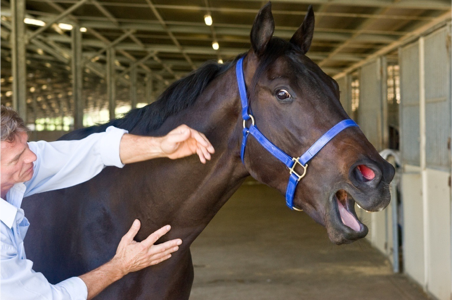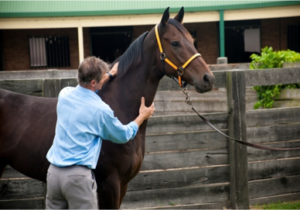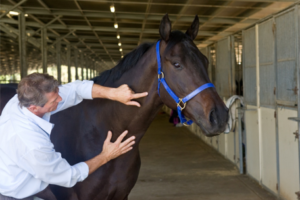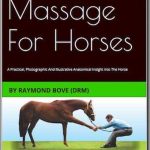
The horse yawning is a good indicator of a state of relaxation. Here I use the side of my hand like a sliding effluerage/friction. You too can create your own techniques – it’s all about contact and keeping the horse happy.
Horses are very sensitive to touch. They respond to a gentle muscle release with a positive emotion. As far as the amount of pressure the therapist puts in…….well, it’s a fine line between just right and too much. That’s why we keep in touch with the horse by how he or she reacts to your pressure.

It doesn’t take long to warm up muscles or even just a singular muscle like the brachiocephalic (above). It is a very long muscle. All horses enjoy any sort of massage here. Normally with high performance horses when they are tight with a bit of acidosis, your fingers literally spring straight out of the brachiocephalic muscle after application of any pressure.
You’ll find this in most horses especially fillies, mares and older horses. It happens in younger ones as well, more commonly racehorses that cop a thumping! In this situation you do what you can with your effleurage to warm the muscle and relax the muscle tissues.
Here I have started to increase my pressure gradually. I worked my way up the neck muscle and now work towards the centre of the neck, coming off the brachiocephalic and onto the cervical ventral serrate muscle.

I like shaking the neck sideways with both hands concurrently. The superficial muscles, the sternomandibular and cervical cutaneous, and deeper omohyoid muscle (where my right hand is), all benefit from this invigorating massage therapy. It’s quite a workout though after you put a bit of effort into it.
Massaging horses is all about the contact you have and where you are working at that particular time.
This horse is in a state of bliss with the contact I have on the jugular groove and how I apply my pressure. Both of my fingers are on the jugular vein. Tight muscles (braciocephalic and sternomandibular) in the neck put pressure on this vein and slow down blood supply to the cranial caval vein and/or around this particular region of the horse’s anatomy.
Usually near the end of a treatment you find yourself coming back to areas of the horse’s body to feel the difference and when the horse lowers its head and neck you can see the pulse up the jugular vein towards the base of the skull. Quite amazing really!
